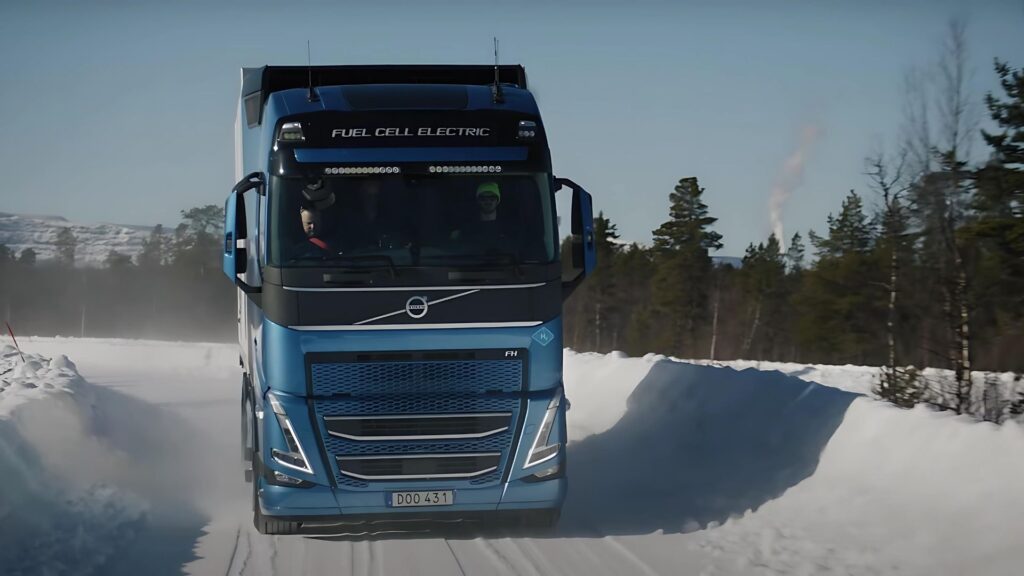Inside Volvo’s New Hydrogen Combustion Engine System – Hydrogen Fuel News

Volvo to Begin Testing Hydrogen Combustion Engines in Trucks by 2026
Volvo Trucks is set to make significant strides towards its net zero emissions goal with the development of trucks powered by hydrogen combustion engines. Announced earlier this year during the ACT Expo in Las Vegas, Volvo revealed plans to commence on-road tests with these innovative trucks by 2026, aiming for a commercial launch towards the end of this decade.
Innovative Technology

Volvo hydrogen truck 3d – Image Credit Volvo
The trucks will feature High Pressure Direct Injection (HPDI) technology, a sophisticated system where a small amount of ignition fuel is injected at high pressure to enable compression ignition before the hydrogen is added. This method ensures robust performance while maintaining efficiency and reducing emissions. Last year, Volvo Group and Westport established a joint venture to fast-track the commercialization of Westport’s HPDI fuel system technology for long-haul and off-road applications.
How HPDI Technology Works: Simplified
Westport’s H2 HPDI (High-Pressure Direct Injection) fuel system is designed specifically for heavy-duty hydrogen engines, making it a powerful and efficient alternative to traditional diesel engines. Here’s a breakdown of how it works:
- Fuel Injection Process:
- Pilot Fuel Injection: The process starts with a small amount of conventional diesel fuel being injected into the engine at high pressure. This diesel acts as an ignition source.
- Hydrogen Injection: Immediately after the pilot diesel is injected, hydrogen is directly injected into the engine at a high pressure.
- Combustion:
- The hydrogen burns using a traditional diffusion flame method, which helps in achieving a clean and efficient combustion process.
- Both the pilot diesel and hydrogen are injected through a specially designed injector called the dual concentric needle HPDI injector.
- Efficiency and Performance:
- By using Diesel Cycle thermodynamics, the HPDI system running on hydrogen achieves higher thermal efficiency and power density compared to standard diesel engines.
- The system not only matches but likely exceeds the efficiency and performance of fuel cells in a typical heavy-duty truck drive cycle.
- Environmental Impact:
- Emission Reductions:
- The H2 HPDI system reduces CO2 emissions by 95% compared to a base diesel engine.
- With further refinements, emission reductions can reach upwards of 98%.
- Despite these significant reductions, a small amount of diesel is still used to initiate combustion, preventing the system from achieving zero emissions.
- Performance:
- Power and torque are increased by 20% over the base diesel engine.
- Thermal efficiency is improved by up to 10%.
- Fuel efficiency and range are comparable to fuel-cell equipped trucks.
- Cost-Effectiveness:
- Offers near-zero greenhouse gas emissions at a lower cost than fuel-cell or battery-electric vehicles.
- Particularly beneficial for heavy-duty, long-haul trucking where hydrogen is seen as the future zero-carbon fuel.
- Emission Reductions:
- Advantages:
- Higher Power/Torque: The system can deliver up to 30% more power and torque than traditional diesel engines.
- Improved Efficiency: It offers up to a 5% improvement in thermal efficiency over base diesel engines.
- Extended Range: With an 80 kg hydrogen storage capacity, it provides an approximate range of 800 km on long-haul trips.
- Low Emissions: It achieves a 94% reduction in CO2 emissions on the World Harmonized Transient Cycle (WHTC).
Interestingly, Volvo plans to conduct customer tests on their hydrogen combustion engine before rolling out their fuel cell system.
Westport Fuel Systems Overview
Westport Fuel Systems, headquartered in Vancouver, Canada, has a significant global presence with facilities across Europe and the United States.
Market Adoption and Growth
Westport’s HPDI technology has experienced substantial market adoption, especially in Europe:
- Thousands of HPDI trucks are operational.
- European HPDI sales have averaged over 100% growth per year for the past three years.
- Many European trucks using HPDI run on biogas or renewable natural gas, meeting stringent environmental regulations.
Specializing in fuel systems for low-carbon fuels, Westport operates in a competitive market with key competitors like Ballard Power Systems, Nuvera Fuel Cells, Kongsberg Automotive, and Plastic Omnium.
Upcoming Milestones and Environmental Impact of Volvo’s Hydrogen-Powered Trucks
Lab testing of these hydrogen-powered combustion engines is currently underway. The on-road tests scheduled for 2026 will be a critical milestone, validating the technology’s practicality and performance in real-world conditions. If successful, the commercial launch is anticipated towards the end of this decade, marking a significant leap towards zero-emission heavy-duty transportation.
While hydrogen combustion does produce low levels of NOx, Volvo’s trucks will be capable of delivering very low CO2 emissions when using renewable HVO (Hydrotreated Vegetable Oil) as the ignition fuel. Under the new EU CO2 emission standards, these trucks will be categorized as “Zero Emission Vehicles” (ZEV), making them a viable option for meeting stringent environmental regulations.
Economic and Practical Advantages
Hydrogen combustion engines can be marginally less efficient than hydrogen fuel cells under specific load conditions. However, they offer substantial economic advantages. These engines are significantly less expensive to produce and maintain, and they come with a lower payload penalty and reduced space requirements compared to fuel cell systems. This makes them a practical and cost-effective solution for the heavy-duty truck market.
Strategic Timing Aligned with Global Hydrogen Infrastructure Expansion
The release of HPDI-equipped trucks is well-timed with global advancements in hydrogen infrastructure. Countries are investing heavily in hydrogen fueling stations, such as the $900M project to create hydrogen plants and refueling stops in British Columbia, and the H2 Gateway project, which aims to establish 20 fill-up stations for hydrogen fuel cell vehicles. These developments ensure that the necessary support for hydrogen-powered transportation will be in place, making HPDI technology a practical and future-ready solution for long-haul trucking.
Conclusion
The HPDI system uses both hydrogen and a small amount of diesel to initiate combustion, maintaining the high compression ratio of a diesel engine. This boosts power and torque by 20% and improves thermal efficiency by up to 10% compared to traditional diesel engines. It also achieves near-zero greenhouse gas emissions at a lower cost than fuel-cell or battery-electric alternatives, making it ideal for long-haul trucking. By utilizing existing diesel infrastructure, HPDI ensures seamless integration, reliability, and compliance with global emissions regulations, offering advantages over other hydrogen combustion engines.
This is why we like this system: One key advantage of HPDI is its ability to use a small amount of ignition fuel to facilitate high-pressure hydrogen injection, resulting in higher thermal efficiency and significantly lower CO2 emissions compared to traditional combustion engines and other hydrogen technologies. We can’t wait to see these trucks in action. Follow us for more updates on hydrogen combustion engine technology!







